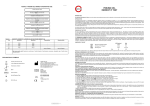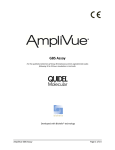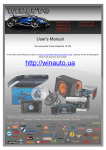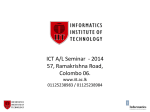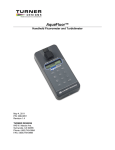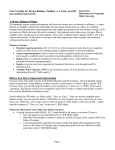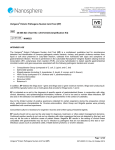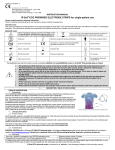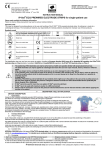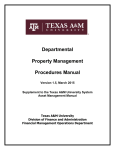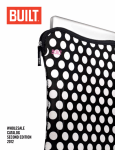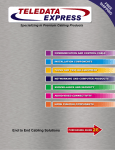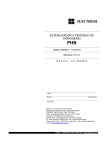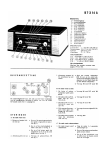Download Biosafety Manual - Collin College Faculty Website Directory
Transcript
BIOSAFETYMANUALFOR BIOSAFETYLEVEL2(BSL‐2)LABS COLLINCOLLEGE PrestonRidgeCampus MICROBIOLOGY RoomLH201|LawlerHall DateofLastRevision:July29,2015 ThisBiosafetyManualhasbeenpreparedfortheCollinCollegelaboratorieslocatedat thePrestonRidgeCampus.Roomnumbers,laboratorydescriptionsandlocationsof safetyrelatedequipmentandproceduresoutlinedinthismanualarespecifictothe PrestonRidgeCampuslaboratoryfacilities.Thismanualhasbeenadaptedfromthe 2012AppendixtotheGuidelinesforBiosafetyinTeachingLaboratoriespublishedby theAmericanSocietyforMicrobiology(ASM). 2 | P a g e I.AuthorityforMicrobiologyLabandPrepAreaRegulations ThePrestonRidgeCampusmicrobiologylabswillfollowtheguidelinespostedbytheU.S. DepartmentofHealthandHumanServices,CentersforDiseaseControlandPrevention (CDC),andNationalInstitutesofHealth(NIH).Theseguidelinesdescribeacceptable biosafetypracticesinbiomedicalandmicrobiologicallaboratoriesandcanbefoundat: http://www.cdc.gov/OD/ohs/biosfty/bmbl5/bmbl5toc.htm. RoomsLH205andLH208atthePrestonRidgeCampusaremultipurposelaboratory rooms(prepareas).BiosafetyLevel1(BSl‐1)precautionswillbefollowedduringroutine mediaprep,autoclaving,andsubculturing. AnytimeanagentrequiringBiosafetyLevel2(BSL‐2)containmentisinuse,biohazard signswillbepostedonthedoorsandtheentireroomwillfollowBSL‐2practices. Room LH201 is the only room on the Preston Ridge Campus where work with BSL‐ 2 agents is permitted. Generally, work with all cultures for the microbiology program at PRC should be performed in Room LH201. SummaryofRecommendedBiosafetyLevelsforInfectiousAgents Biosafety Level 1 Agents Notknowntocause diseaseinhealthy adults. Practices SafetyEquipment (PrimaryBarriers) StandardMicrobiologicalPractices Nonerequired (SMP) Facilities (SecondaryBarriers) Openbench‐topsink required BSL‐1practices(SMP)plus: 2 Associatedwithhuman disease,hazard= autoinoculation, ingestion,mucous membraneexposure Limitedaccess Biohazardwarningsigns Sharpsprecautions Biosafetymanual defininganyneeded wastedecontamination ormedicalsurveillance policies Primarybarriers=ClassIorII BSCsorotherphysical containmentdevicesusedforall manipulationsofagentsthat BSL‐1plusensurethatan causesplashesoraerosolsof autoclaveisavailable infectiousmaterialsaswellas PPEsuchaslaboratorycoats, gloves,faceprotectionasneeded BSL‐2plus: 3 BSL‐2practiceplus: Indigenousorexotic agentswithpotential foraerosol transmission;disease mayhaveseriousor lethalconsequences. PrestonRidgeCampus Controlledaccess Decontaminationofall waste Decontaminationoflab clothesbefore laundering Primarybarriers=ClassIorII BSCsorotherphysical containmentdevicesusedforall manipulationsofagentsaswell asPPEsuchasprotectivelab clothing,glovesandrespiratory protection,asneeded BiosafetyManual(BSL2)|Fall2015 Physical separationfrom accesscorridors Self‐closing, doubledoor access Exhaustairnot recirculated Negativeairflow intolaboratory CollinCollege 3 | P a g e ThePrestonRidgeCampusMicrobiologyLabsarelimitedtoworkingwithorganismsrequiringup toBiosafetyLevel2containmentonly. OrganismsrequiringBiosafetyLevel3orBiosafetyLevel4containmentarenotpermittedto bepurchased,storedorotherwiseacquiredbyCollinCollege. StandardMicrobiologicalPractices,asdefinedbytheCDC’sBiosafetyinMicrobiologicaland Biomedicallaboratories,5thEditionalongsideourcurrentmicrobiologylaboratorypracticesatthe PrestonRidgeCampus: CDCRecommendationsfor StandardMicrobiologicalPractices 1.Thelaboratorysupervisormustenforcetheinstitutional policiesthatcontrolaccesstothelaboratory. 2.Personsmustwashtheirhandsafterworkingwith potentiallyhazardousmaterialsandbeforeleavingthe laboratory. 3.Eating,drinking,smoking,handlingcontactlenses, applyingcosmetics,andstoringfoodforhuman consumptionmustnotbepermittedinlaboratoryareas. Foodmustbestoredoutsidethelaboratoryareain cabinetsorrefrigeratorsdesignatedandusedforthis purpose. 4.Mouthpipettingisprohibited;mechanicalpipetting devicesmustbeused. 5.Policiesforthesafehandlingofsharps,suchasneedles, scalpels,pipettes,andbrokenglasswaremustbedeveloped andimplemented.Wheneverpractical,laboratory supervisorsshouldadoptimprovedengineeringandwork practicecontrolsthatreduceriskofsharpsinjuries. Precautions,includingthoselistedbelow,mustalwaysbe takenwithsharpitems.Theseinclude: a.Carefulmanagementofneedlesandothersharpsareof primaryimportance.Needlesmustnotbebent,sheared, broken,recapped,removedfromdisposablesyringes,or otherwisemanipulatedbyhandbeforedisposal. b.Useddisposableneedlesandsyringesmustbecarefully placedinconvenientlylocatedpuncture‐resistant containersusedforsharpsdisposal. c.Non‐disposablesharpsmustbeplacedinahardwalled containerfortransporttoaprocessingareafor decontamination,preferablybyautoclaving. d.Brokenglasswaremustnotbehandleddirectly.Instead, itmustberemovedusingabrushanddustpan,tongs,or forceps.Plasticwareshouldbesubstitutedforglassware wheneverpossible. PrestonRidgeCampus CurrentPracticesatthePrestonRidgeCampus 1.Allsciencelaboratoryclassroomsandprepareasare secureareaswithaccesscontrolledbykeypadlocks.Access codesareonlyprovidedtoauthorizedfacultyandstaff. Realorperceivedbreachesinsecurityarereportedtothe CampusPoliceDepartment. 2.Handwashingisrequiredbyallstudentsfacultyand staff.WASHyourhandswithsoapandwarmwaterbefore leavingthelaband/orafterremovingcontaminatedgloves. Donotwearpersonalprotectiveequipment(gloves,lab coats,etc.)outofthelaboratoryareaunlessyouare transportinghazardousmaterialsorwastes. 3.DONOTeat,drink,smoke/usetobaccoproducts,store food,orapplycosmeticsinthelaboratory.Facultyandstaff arepermittedtohavedrinksinCLOSEDcontainersatPREP AREAcomputerworkstationsonly.Foodanddrinkarenever permittedinanyofthelaboratoryclassrooms. 4.MOUTHPIPETTINGisstrictlyprohibited;usemechanical pipettingdevices. 5.SeeWasteManagementPlanandBiologicalWasteTable forcurrentpractices. BROKENGLASS:Donothandlebrokenglasswarewithbare hands.Disposeofallcrackedorbrokenglasswareina puncture‐resistantcontainer–NOTtheregulartrash. Discusswithinstructorwhatwasbrokenandwhereto discardit.Discardbrokenglasswarecontaminatedwith hazardouschemicalsinanappropriatelylabeledcontainer. Seeyourinstructororamemberofthelabstaffifa hazardouswaste/brokenglasscontainerisneeded. Lubricateglasspiecesbeforeinsertingintocorks,stoppers, etc.Topreventglassbreakage,insertglasswithatwisting motion. MedicalWasteContainers:Redplasticmedicalwaste containersaretobeusedforanyglassorsharpobjectthat hascomeincontactwithpotentiallybiohazardmaterial suchasbacteria,blood,urine,salivaand/orotherhumanor animalfluids. BiosafetyManual(BSL2)|Fall2015 CollinCollege 4 | P a g e 6.Performallprocedurestominimizethecreationof splashesand/oraerosols. 7.Decontaminateworksurfacesaftercompletionofwork andafteranyspillorsplashofpotentiallyinfectious materialwithappropriatedisinfectant. 8.Decontaminateallcultures,stocks,andotherpotentially infectiousmaterialsbeforedisposalusinganeffective method.Dependingonwherethedecontaminationwillbe performed,thefollowingmethodsshouldbeusedpriorto transport. a.Materialstobedecontaminatedoutsideoftheimmediate laboratorymustbeplacedinadurable,leakproof containerandsecuredfortransport. b.Materialstoberemovedfromthefacilityfor decontaminationmustbepackedinaccordancewith applicablelocal,state,andfederalregulations. 9.Asignincorporatingtheuniversalbiohazardsymbol mustbepostedattheentrancetothelaboratorywhen infectiousagentsarepresent.Thesignmayincludethe nameoftheagent(s)inuse,andthenameandphone numberofthelaboratorysupervisororotherresponsible personnel.Agentinformationshouldbepostedin accordancewiththeinstitutionalpolicy. 10.Aneffectiveintegratedpestmanagementprogramis required. 11.Thelaboratorysupervisormustensurethatlaboratory personnelreceiveappropriatetrainingregardingtheir duties,thenecessaryprecautionstopreventexposures, andexposureevaluationprocedures.Personnelmust receiveannualupdatesoradditionaltrainingwhen proceduralorpolicychangesoccur.Personalhealthstatus mayimpactanindividual’ssusceptibilitytoinfection, abilitytoreceiveimmunizationsorprophylactic interventions.Therefore,alllaboratorypersonneland particularlywomenofchildbearingageshouldbeprovided withinformationregardingimmunecompetenceand conditionsthatmaypredisposethemtoinfection. Individualshavingtheseconditionsshouldbeencouraged toself‐identifytotheinstitution’shealthcareproviderfor appropriatecounselingandguidance. Preparingculturesinvolumesthatexceedthecapacityofa 13mmODx100mmtesttube(approximately8milliliters) arenotpermitted.Theaddeduseofafaceshieldis requiredwhenworkinvolvinganticipatedaerosolsor splashesmustbeperformed. 7.CLEANanddisinfectworksurfacesatthebeginningand endofeverylabperiod.Keepextrabooks,bagsandclothing indesignatedplacessoyourworkareaisuncluttered. 9.SeeWasteManagementPlanforafulldescriptionof ourbiologicalwastemanagementpractices.Seethe BiologicalWasteTableforbiologicalwastestream profilesandcurrentdisposalmethods. 1)Biohazardbags(fromstepcans):bagsaresterilizedon‐ siteinaccordancewiththeprovisionsof25TAC§1.136and disposedofassolidwaste. 2)RedSharpsContainer:regulatedmedicalwasteis disposedofthroughacontractedvendor. 3)PipetteTray(forGLASSserologicalpipettesonly):glass pipettesaredisinfectedandreused. 4)WhiteBuckets(fortubes):tubesandcapsareautoclaved andreused.Sterilizedliquidmediaisdisposedofviasanitary sewer.Sanitizedsolidmediaiscollectedinacontainer, labeledinaccordancewiththeprovisionsof25TAC§1.136 anddisposedofassolidwaste. 5)RegularTrash:itemsthrownintotheregulartrashcans areforuncontaminatedwasteonly.Thiswastegoestothe dumpsters. 6)BrokenGlassBucket:uncontaminatedbrokenglassis disposedofinapunctureresistantcontainer. 7)Biohazard+HazardousWaste:Tubesarefirstdisinfected toremovebiohazard.Remainingwasteistreatedand disposedofasHazardousWaste. 8)Animalwastes(carcasses,tissues,bones,skin)are collectedforincinerationthroughacontractedvendor. 9.Asignincorporatingtheuniversalbiohazardsymbolis postedattheentranceoftheinstructionallaboratory. 10.IPMisundertheauthority ofFacilities/Plant Operations. 11.Alllaboratorypersonnelaretrainedannuallyinthe followingareas: PrestonRidgeCampus RCRAHazardousWasteGeneratorTraining DOTHazmatTraining BiosafetyTraining OrientationtoLaboratorySafety SafetyShowersandEyeWashesintheLaboratory FlammablesandExplosivesintheLaboratory TheFormaldehydeStandard ElectricalSafetyintheLaboratory LaboratoryErgonomics UsingMSDSsintheLaboratory LaboratoryHoods PreventingContaminationintheLaboratory SafeHandlingofLaboratoryGlassware PlanningforLaboratoryEmergencies TheBasicsofFirstAid BiosafetyManual(BSL2)|Fall2015 CollinCollege 5 | P a g e II.Regulations A.Access,TrainingandResponsibilities 1.AccesstoLH201islimitedtoindividualsinvolveddirectlyinmediaprep,clean‐up, laboratoryprep,facultyfacilitatedresearch(CASMNS),andbuildingmaintenance.CASMNS studentsparticipatinginresearchrelatedprojectsmustcompleteadditionalsafetytraining priortoworkinginLH201. 2.ThelabandpreproomdoorswillbeclosedwhenaBSL‐2agentisinuse. 3.Allstaffandstudentsarerequiredtoread,understand,andfollowtheseregulations beforeworkinginLH201. 4.AllstaffandstudentsworkinginLH201willreceivetrainingfromtheirinstructoror supervisorconcerninguseoftheequipment. 5.TheLabManagerwilltrainstaffandfacultywilltrainstudentsonaseptictechniques appropriateforhandlingpathogenicagents.Thiswillincludethepotentialhazards associatedwiththeworkinvolved,thenecessaryprecautionstopreventexposures,and theexposureevaluationprocedures. 6.Laboratorystaffmembersreceiveannualupdatesoradditionaltrainingasnecessaryfor proceduralorguidelinechanges.BiosafetyTrainingisperformedanddocumented annuallyforallmicrobiologyfacultyandstaff.Studentsmustdemonstrateproficiencyin BSL‐1laboratorysafetytechniquespriortobeingpermittedtoworkwithBSL‐2organisms. Facultymembersareresponsiblefortrainingandtestingtheirstudentsinallareasof laboratorysafetyandbiosafetypractices. 7.Laboratorypersonnelandstudentsareadvisedofspecialhazardsandarerequiredto readandfollowinstructionsonpracticesandprocedures. 8.Anystafforstudentsfoundinviolationoftheregulationsmayhavetheiraccesstothe laboratoryareasterminated. 9.TheLaboratoryManagerandteachingfacultyareresponsibleforseeingthatthe consequencesofstudentorstaffactionsarerectified,includingcorrectionofdamagesand violationsandtake‐downofexperiments. B.Apparel 1.PersonnelenteringroomLH205orLH201willberequiredtowearclosed‐toeshoesand havelonghairtiedback. PrestonRidgeCampus BiosafetyManual(BSL2)|Fall2015 CollinCollege 6 | P a g e 2.PersonnelworkinginLH201atBSL‐2mustwearlabcoatsatalltimeswhenculturesare inuse.Thisprotectiveclothingisremovedandleftinthelaboratorybeforeleavingfornon‐ laboratoryareas(e.g.,restroom,cafeteria,library,oradministrativeoffices). 3.Glovesmustbewornwhenhandlingmicroorganismsorhazardouschemicals.Glovesare disposedofwhencontaminatedandremovedwhenworkwithinfectiousmaterialsis completedorwhentheintegrityofthegloveiscompromised.Glovesareplacedina biohazardbagandautoclavedpriortodisposal.Disposableglovesarenotwashed,reused, orusedfortouching“clean”surfaces(keyboards,telephones,etc.),andtheyshouldnotbe wornoutsidethelab.Handsaretobewashedfollowingtheremovalofgloves. 4.Duringworkwithanylivecultures,chemicalsplashgogglesmustbewornfornormallab proceduresinvolvingliquidculturesthatdonotgenerateasplashhazard(e.g.,proper pipetting,spreadplates,etc.).Chemicalsplashgogglesandfaceshieldsaretobeworn whenperformingproceduresthatmaycreateasplashhazard.Ataminimum,chemical splashgogglesmustbewornwhenworkingwithbacterialcultures(forbothBSL‐1and BSL‐2organisms). 5.Labcoatsshouldneverbesharedandmustalwaysstayinthelaboratory.Students shouldstoretheirlabcoatinaziptopbagthatisthenkeptinadesignatedspaceinthe laboratory.Attheendofthesemester,itemskeptinthelabmustbedecontaminatedbefore studentsareallowedtotakethemhome.Ziptopbagsareavailablefromamemberofthe labstaff.Disposablelabcoatsmustbedisposedofinaredbagandautoclaved. 6.Shortsandsleevelessshirtsareneverrecommendedforthelaboratorysetting. C.StandardLaboratoryPractices 1.Eating,drinking,smoking,handlingcontactlenses,andapplyingcosmeticsarenot permittedinthelab.Cellphones,tablets,andlaptopsshouldnotbeusedinLH201.Food anddrinkforhumanconsumptionisnevertobestoredthelab. 2.Anorangebiohazardsignmustbepostedontheentrancetothelaboratorywhen biologicalagentsareinuse.Informationtobepostedincludestheagent(s)inuse, biohazardsymbol,biosafetylevel2,anypersonalprotectiveequipmentthatmustbeworn inthelaboratory,andanyproceduresrequiredforexitingthelaboratory. 3.Personsmustwashtheirhandsuponenteringthelab,aftertheyfinishworkinginthe lab,afterremovinggloves,andbeforeleavingthelaboratory. 4.WorksurfacesmustbedecontaminatedpriortobeginninganyworkinLH201,on completionofworkorattheendofthedaywith10%bleachsolution,preparedLysol solutionor70%ethanolsolution.Anyspillorsplashofviablematerialshouldbe PrestonRidgeCampus BiosafetyManual(BSL2)|Fall2015 CollinCollege 7 | P a g e decontaminatedwith25%bleachorLysolconcentrate.NOTE:Materialsthathavebeen soakedinbleachshouldneverbeautoclaved. 5.Allproceduresareperformedcarefullytominimizethecreationofsplashesoraerosols. 6.Mouthpipettingisprohibited;mechanicalpipettingdevicesareused. 7.Needlesandsyringesmaybeusedforreconstitutingreagents.Afteruse,thesematerials areplacedinapuncture‐proofredsharpscontainer.Donotrecapneedles. 8.Allcultures,swabs,andwastecontainersmustbedecontaminatedbeforedisposalby autoclaving.Materialstobedecontaminatedoutsideoftheimmediatelaboratoryare placedinadurable,leak‐proofcontainerfortransportfromthelaboratory.Allredsharps containersaretransportedoffsitefordecontaminationandfinaldisposal.Fullredsharps containersshouldbebroughttoRoomJ223Fforfinalpackagingpriortoshippingoffsite. 9.Microincineratorsarerecommendedfortheteachinglaboratoryduetothedangers posedbyopenflamesinthelaboratory.Themicroincineratorreachesaninternal temperatureof1500F,easilysterilizingloopsandneedlesinjustafewseconds. Microincineratorsalsoeliminatethepossibilityofculturescreatingsplatteroraerosolizing duringthesterilizationprocess. Heat‐fixingcanbeaccomplishedbyholdingtheslideovertheopeningofthe microincinerator.MicroincineratorsareusedintheLH205andLH201laboratoriesinstead ofthetraditionalBunsenBurners.Therearetwoincineratorsateachlabbench.DONOT leaveloopsorneedlesunattendedintheincineratoratanytime.AlwaysturnOFFand UNPLUGtheincineratoratthecompletionofthelab. D.SpecialPractices 1.LaboratoryAccess AccesstothelaboratoryislimitedorrestrictedbytheLaboratoryManagerwhenwork withinfectiousagentsisinprogress.Personswhoareatincreasedriskofacquiring infection–e.g.,thosewhoareimmunocompromisedorimmunosuppressed–orforwhom infectionmayhaveseriousconsequences,shouldconsultwiththeirphysiciantodetermine theappropriatelevelofparticipationinthelab.Employeesthathaveamedicalcondition thatmightputthematagreaterriskforinfectionshouldconsultwiththeirsupervisor priortoconductinganyworkintheBSL‐2laboratory.Studentsthathaveamedical conditionthatmightputthematagreaterriskforinfectionshouldconsultwiththeir instructorpriortoconductinganyworkintheBSL‐2laboratory. PrestonRidgeCampus BiosafetyManual(BSL2)|Fall2015 CollinCollege 8 | P a g e 2.LaminarFlowHood/CleanBench RoomLH205isequippedwithaLabconcoCleanBenchthatistobeusedforthe preparationofmicrobiologicalmediaandothertasksnotinvolvingbiologicalagentsor hazardouschemicals.Aspictured,themotor/blowerassemblypullsairthroughthepre‐ filtersonthetopofthebench,andflowsthroughtheHEPAfilter,whichthenflows horizontallythroughtheworkarea. Becauseairfromtheworkareaisdisperseddirectlyintothe laboratory,thePurifierCleanBenchshouldneverbeusedin conjunctionwithbiohazardousmaterial. TheCleanBenchinLH205isrecertifiedannually.Thepre‐ filters,locatedatthetopoftheunitshouldbereplacedevery 12weeks. UseoftheUVlightisnotpermittedsincethisunitislocated inasharedpreparea,makingitdifficulttorestrictaccess whentheUVlightisinuse. ReadtheUser’sManuallocatedinLH205priortooperating theCleanBench.Reportanyproblemswithoperationtothe LabManager. Followtheweekly,monthlyandquarterlyroutinemaintenanceschedulepostedontheside oftheunit. 3.BiologicalSafetyCabinet ThePrestonRidgecampusisnotequippedwithaBiologicalSafetyCabinet.Procedures thatcreatethepotentialforcreatinginfectiousaerosolsorsplashesshouldbeavoided. Preparingculturesinvolumesthatexceedthecapacityofan18mmODx150mmtesttube (approximately35milliliters)arenotpermitted.Theaddeduseofafaceshieldisrequired whenworkinvolvinganticipatedaerosolsorsplashesmustbeperformed. E.TransferofMaterials 1.Culturesandpotentiallyinfectiouswastesareplacedinacontainerthatpreventsleakage duringcollection,handling,processing,storage,andtransport. PrestonRidgeCampus BiosafetyManual(BSL2)|Fall2015 CollinCollege 9 | P a g e 2.Ifculturesorbiologicalwastesmustbetransferredbetweenbuildings,materialsmustbe carriedwithinsecondarycontainmentwhileenroute.Alwaystransportwastesonacart. F.DisposalofMaterialsandDecontamination 1.Laboratoryequipmentandworksurfacesshouldbedecontaminatedwith10%bleach, preparedLysolsolutionor70%ethanolsolutiononaroutinebasisandafterworkwith infectiousmaterialsisfinished.Overtspills,splashes,orothercontaminationbyinfectious materialsshouldbedecontaminatedwith25%bleachorLysolconcentrate.Alcoholbased disinfectantsshouldneverbeusednearanopenflameorotherheatsource.NOTE: Materialsthathavebeensoakedinbleachshouldneverbeautoclaved. 2.Spillsandaccidentsthatresultinobviousexposurestoinfectiousmaterialsaretobe immediatelyreportedtotheLabManager.Medicalevaluation,surveillance,andtreatment areprovidedasappropriateandwrittenrecordsaremaintained. 3.Brokenglasswarethatdoesnotcontainliveculturesshouldbesweptupwiththebroom anddustpananddiscardedintheglassdisposalbucket.Brokenglasswareshouldneverbe handledwithbarehands. 4.BrokenglasswarethatcontainsliveculturesshouldbesaturatedwithLysolconcentrate. After15minutes,thedebrisshouldbecarefullycollectedfordisposalinaredsharps container.Smallglassfragmentsshouldbepickedupwithforceps.Papertowelsusedfor clean‐upshouldbediscardedintheautoclavestepcanforfinalsterilizationanddisposal. 5.ThePRCMicrobiologyLabsadheretotheTexasRegulationsonMedicalWasteas outlinedin30TAC330,SubchapterY.Autoclaveefficacytestingisperformedonaweekly basis. 6.AllbiologicalwastethatistreatedonsiteissterilizedbyautoclavinginRoomLH205. Eachredbagissterilizedataminimumof121Cat15psifor60minutes.Eachloadof tubestobedecontaminatedissterilizedataminimumof121Cat15psifor60minutes. Baggedandtubedwasteisnevertobesterilizedinthesameload.Runonebagpercycle andruntubesseparatefrombags. RecordKeepingandAutoclaveTesting TheTexasCommissiononEnvironmentalQuality(TCEQ)regulatesthehandlingandon‐ sitetreatmentofallregulatedmedicalwaste(RMW).Thesewastestreamsinclude microbiologywaste,bulkblood(volumesover100milliliters),sharpsandpathological waste.PerTCEQregulations,thefollowingdocumentationmustbekeptforallRMWthatis treatedon‐site.CollinCollegetreatsRMWbysteamsterilizationorchemicaldisinfection whensteamsterilizationisnotpractical. PrestonRidgeCampus BiosafetyManual(BSL2)|Fall2015 CollinCollege 10 | P a g e Ageneratorofmorethan50poundspercalendarmonthofmedicalwastethattreatsallor partofthewasteson‐siteandpersonsthattreatmedicalwastesoff‐siteshallmaintaina writtenrecordthat,ataminimum,containsthefollowinginformationforeachbatchof wastetreated: (A)thedateoftreatment; (B)theamountofwastetreated; (C)themethod/conditionsoftreatment; (D)thename(printed)andinitialsoftheperson(s)performingtreatment;and (E)awrittenprocedurefortheoperationandtestingofanyequipmentusedanda writtenprocedureforthepreparationofanychemicalsusedintreatment. Theoperatorshalldemonstrateaminimumfourlogtenreduction(asdefinedin25TAC '1.132(relatingtoDefinitions)onroutineperformancetestingusingappropriateBacillus speciesbiologicalindicators(asdefinedin25TAC'1.132).Theoperatorshallconduct testingatthefollowingintervals: (I)forgeneratorsofmorethan50poundsbutlessthanorequalto100poundsper month,testingshallbeconductedatleastoncepermonth; (II)forgeneratorsofmorethan100poundsbutlessthanorequalto200pounds permonth,testingshallbeconductedatleastbiweekly;and (III)forgeneratorsofmorethan200poundspermonthandpersonsthattreat medicalwastesoff‐site,testingshallbeconductedatleastweekly. ThePrestonRidgeCampuscangenerateover150poundsofautoclavedredbagsaloneina singlemonth.Inordertoassurevalidationtestingcompliance,autoclavetestingis performedonaweeklybasiswithGeobacillusstearothermophilus,sporepopulation105. Instructionsfortheuseofself‐containedbiologicalindicators: (VWRItem#95029‐702) http://www.namsa.com/Portals/0/Documents/SCS‐05‐technicaldatasheet.pdf 1)TobecompletedbyfulltimestaffmemberorLabManager:OnTuesdayor Wednesdayofeachweek,labeloneunusedself‐containedbiologicalindicator (SCBI)withthedateandwasteloadnumber.Recorddateoftest,SCBIlotnumber, expirationdate,wasteloadnumberandusernameonAutoclaveTestLog. PrestonRidgeCampus BiosafetyManual(BSL2)|Fall2015 CollinCollege 11 | P a g e 2)PlacelabeledSCBIinsidetheloadtobetested.Donottesttheautoclaveonan emptyload.Theindicatorshouldbepositionedinsidetheautoclavebagoramong theracksinthemostinteriorpartoftheload.Securetheindicatortoastripof autoclavetapeoralongglassrodinordertosafelyretrievethecapsuleafter sterilization. 3)Allowcapsuletocoolsoitmaybesafelyhandled.Immediatelyfollowing sterilizationandcooldown,sealthecapbypressingdownfirmlyuntilthemedia ampouleiscrushed.Thisactivatestheampoule. 4)PlaceactivatedSCBIintoa55–60°Cincubatorforaminimumof24hours,maxof 30hours. 5)Tobecompletedbyasecondstaffmemberorlabmanager:Examineforgrowth after24hours,recorddate/time,results(Color&Pass/Fail)andyourname. Prolongedincubationmayhaveadversepositiveeffects. 6)InterpretingValidationResults:Theacidproductionassociatedwithbacterial growthcausesashiftinthecoloroftheculturemediumfrompurpletoyellow. Purple=Negativeforgrowth;Yellow=Positiveforgrowth* 7)Discard/Disposal:AutoclaveallactivatedSCBIsfor45minutesat121°Cpriorto discard.SterilizedSCBIsmaybedisposedofinaredsharpscontainer. 8)StoreunusedSCBIsintheiroriginalbox,atroomtemperature.Donotfreezeor refrigerate. *ANYINSTANCESOFAFAILEDVALIDATIONTEST(YELLOWRESULT)MUSTBE REPORTEDTOTHELABMANAGERIMMEDIATELY.ANYFUTHERUSEOFTHE AUTOCLAVEFORWASTETREATMENTPURPOSESMUSTBEHALTEDUNTILTHEUNIT CANBESERVICEDANDRE‐VALIDATED.ANYMEDIAPREPTHATISPERFORMED BEFORETHEUNITCANBEINSPECTEDMAYBECOMPROMISED. BiologicalWaste:Anywastethatispotentiallybiohazardous,infectiousorpathological Biologicalwasteincludes: humanandanimalblood,bloodproducts,bodyfluids,tissue,andbodyparts; culturesandstocksofinfectiousagents; dissectionwastefrompreservedorfreshspecimens; itemssuchasgloves,papertowelsandplasticthataresoiledwithinfectious materials. PrestonRidgeCampus BiosafetyManual(BSL2)|Fall2015 CollinCollege 12 | P a g e Biologicalwastemayalsoincludesharpsmaterials(slides,scalpels,pipettes, etc.). PackagingandLabelingBiologicalWasteforDisposal BiohazardCans/AutoclaveBags RedbiohazardbagsinsideoftheBiohazardCansareusedforthecollectionofbiological wastethatistobeautoclaved.Sharpitems(loops,swabs,slides,glasspipettes)should neverbeplacedinanautoclavebagsincetheseitemscanpuncturethebag.Autoclavebags areusedtocollectcontaminateddisposablepetridishes,gloves,papertowels.Sharpsof anykindareneverpermittedinanautoclavebag. BiohazardSharpsContainers Theredsharpscontainerslocatedthroughoutthelaboratoryclassroomsandprepareas aretocollectonlythefollowingitems:glassslidesandcoverslips,contaminatedswabsor disposableloops,brokenglassthatiscontaminatedwithabiologicalorinfectiousagent, smallglassbottles/vialsofanimalblood(10millilitersorless.Fullsharpscontainersareto betransportedtoJ223Fforcollection. PathologicalWasteContainers(LocatedinJ223F) These31galloncollectionboxesarereservedspecificallyforthefollowingitems: dissectionwaste(carcasses,skin,bone,tissue,etc.)fromallpreservedandfreshspecimens. Dissectionwasteistobeplacedintoaredbag,sealedandthenplacedinthePathological WasteContainerforpickupanddisposal.PathWasteContainersaredisposedofby incinerationthroughacontractedvendor.Microbiologylabsdonotgeneratedissection waste. G.HygieneandHousekeeping 1.Benchtopsareimpervioustowaterandareresistanttomoderateheatandtheorganic solvents,acids,alkalis,andbleachusedtodecontaminatetheworksurfaces.Allbenchtop surfacesinLH205andLH201shouldbecleanedandsanitizedonadailybasis. 2.Laboratoryfurnitureiscapableofsupportinganticipatedloadinganduses.Spaces betweenbenches,cabinets,andequipmentaretoremainaccessibleforcleaning.Chairs usedinlaboratoryworkarecoveredwithanonporousmaterialthatcanbeeasily decontaminated.Allseatingcoversshouldbecleanedandsanitizedonaweeklybasis. 3.SafetyDataSheets(SDS)arelocatedinLH201ontopoftheincubatornearthe laboratoryentrance. PrestonRidgeCampus BiosafetyManual(BSL2)|Fall2015 CollinCollege 13 | P a g e 4.FirstaidkitsarelocatedinLH201attherearoftheroomnearthemiddlesink. 5.EyewashstationandsafetyshowerarelocatedinLH201nearthelaboratoryclassroom door. 6.Fireextinguishersaremountedonthewallnearthelaboratoryclassroomdoorin LH201. 7.RefrigeratorsandIncubatorsshouldbecleanedandsanitizedonamonthlybasiswitha freshlyprepared10%bleachsolution. H.BiologicalSpillResponse Thefollowingbiologicalspillkitmaterialsshouldbekeptineachlaboratorywherework withmicroorganismsisconducted.Basicmaterialsare:disinfectant(householdbleachor Lysol I.C. Quaternary disinfectant), paper towels, nitrile gloves, autoclave bags, sharps container,andforcepstopickupbrokenglass. For any biological spill, first notify others in the laboratory so they will not unknowingly spreadthecontamination.Forbiologicalorchemicalspillsofalargevolume,evacuatethe areaandcallforoutsidehelp. CollinPoliceDepartment:5555 CityofFriscoFireDepartment:911 Forsmall,commonlaboratoryspills: 1.Weargloves,labcoatandgoggles.Ifsplashingislikely,alsowearfaceshield. 2.Useforcepstopickupbrokenglassanddiscardintoaredsharpscontainer.Donotpickup brokenglasswithglovedorbarehands. 3.Coverspilledmaterialwithpapertowels. 4.Carefullypour(donotspray)dilutedLysolI.C.Quaternarydisinfectant(fromspraybottlesor carboys)ontopapertowelsinsufficientquantitytoensureeffectivemicrobialinactivation. 5.Allowa20‐minutecontactperiod. 6.Pickuppapertowelsanddisposeinbiohazardwastecontainer. 7.Re‐wipespillareawithLysoldisinfectant.Placepapertowelsinbiohazardcontainer. 8.MistareawithLysoldisinfectantorafreshlyprepared10%bleachsolution.Allowtreatedareato airdry.Keepareafreefromtrafficuntilallsurfaceshavebeenproperlydisinfected,driedandspill materialscleanedup. PrestonRidgeCampus BiosafetyManual(BSL2)|Fall2015 CollinCollege 14 | P a g e 9.Placeallcontaminatedmaterials,includinganycontaminatedPersonalProtectiveEquipment, intobiohazardwastecontainerandautoclave.DONOTautoclavewastematerialsthathavesoaked inbleachsolutions. 10.Washhandswithsoapandwater. I.ExposuresintheLaboratory AllsuspectedorknownexposuresmustbeappropriatelydocumentedonanIncidentReportform andsubmittedtotheLabManagerpromptlyaftertheincident. BiologicalExposure Removeanycontaminatedclothingorjewelryandwashtheskinexposedtotheagentwith antibacterialsoap. Autoclaveanycontaminatedclothingbeforedisposalorfurtherlaundering.Decontaminateany surfacesbysprayingtheareawithLysoldisinfectantorfreshlyprepared10%bleachsolution. Ifyoubelieveyoumayhavebeenexposedtoabiologicalagent,notifyyourinstructorortheLab Managerandseekimmediatemedicalattention. Ifyoususpectyouhavealab‐acquiredillnessregardlessofarecentexposure,seekmedical attention. ChemicalExposure Formostchemicalexposurestotheskin,removeanycontaminatedclothingandwashthechemical offwithwaterforaminimumof15minutes.Safetyshowersshouldbeutilizedintheeventoflarger exposures. J.MicrobiologyCultureList(BIOL2420/2421) BiosafetyLevel1 Alcaligenesfaecalis Bacillusbrevis Bacilluscoagulans Bacilluslicheniformis Bacillusmegaterium Bacilluspolymyxa Bacillussphaericus Bacillusstearothermophilus Bacillussubtilis Citrobacterfreundii Clostridiumsporogenes Enterobacteraerogenes Enterobactercloacae Escherichiacoli Flavobacteriumcapsulatum Klebsiellaoxytoca Micrococcusluteus Mycobacteriumsmegmatis Providenciaalcalifaciens Pseudomonasfluorescens Pseudomonasputida Saccharomycescerevesiae Serratiamarcescens Staphylococcusepidermidis Staphylococcusintermedius Staphylococcussaprophyticus Staphylococcusxylosus Streptococcusbovis Streptococcusmutans BiosafetyLevel2 Bacilluscereus Edwardsiellatarda Enterococcusfaecalis Klebsiellapneumonia Morganellamorganii Proteusmirabilis Proteusvulgaris Pseudomonasaeruginosa Shigellaboydii Staphylococcusaureus Streptococcusagalactiae Streptococcuspyogenes Streptococcusequi Streptococcusequisubspecies zooepidemicus PrestonRidgeCampus BiosafetyManual(BSL2)|Fall2015 CollinCollege 15 | P a g e Resources BiosafetyinMicrobiologicalandBiomedicalLaboratories(BMBL)5thEdition http://www.cdc.gov/biosafety/publications/bmbl5/index.htm GuidelinesforBiosafetyinTeachingLaboratories http://www.asm.org/images/asm_biosafety_guidelines‐FINAL.pdf AppendixtotheGuidelinesforBiosafetyinTeachingLaboratories http://www.asm.org/images/Education/FINAL_Biosafety_Guidelines_Appendix_Only.pdf MicrobiologicalandChemicalExposureAssessment http://www.epa.gov/nerlcwww/microbiology.html LaboratoryBiosafetyManual‐ThirdEdition http://www.who.int/csr/resources/publications/biosafety/WHO_CDS_CSR_LYO_2004_11/ en/ CultureSelection http://www.atcc.org/ LaboratoryTrainingResources LaboratoryBiosafetyLevels(FOCUS,Volume5.1) http://cdc.train.org/DesktopModules/eLearning/CourseDetails/CourseDetailsForm.aspx? courseId=1030020 CoreMicrobiologySkills http://cdc.train.org/DesktopModules/eLearning/CourseDetails/CourseDetailsForm.aspx? courseId=1035232 RoutineMicroscopy http://cdc.train.org/DesktopModules/eLearning/CourseDetails/CourseDetailsForm.aspx? courseId=1046095 AutoclaveSafetyhttp://www.youtube.com/watch?v=T901F2W7wks PrestonRidgeCampus BiosafetyManual(BSL2)|Fall2015 CollinCollege















